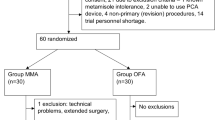Background
Parenteral administration of opioids and NSAIDs has been the mainstay for postoperative pain control in patients undergoing laparoscopic adjustable gastric banding (LAGB). Both classes of drugs, however, are associated with serious adverse effects. An addition of complimentary analgesic techniques may decrease requirement for traditional analgesics, thus reducing the incidence of side-effects. We designed the study to evaluate the effectiveness of Lavender aromatherapy in reducing opioid requirements after LAGB.
Methods
A prospective randomized placebo controlled study was carried out on 54 patients undergoing LAGB. Upon arrival to the post-anesthesia care unit (PACU), patients in the study group were treated with lavender oil, which was applied to the oxygen face mask; the control group patients received nonscented baby oil. Postoperative pain was treated with morphine. Numerical rating scores (0–10) were used to measure the level of pain at 5, 30, and 60 min. Sedation was evaluated using the Observer Assessment of Alertness/Sedation scale (0–5). Data analyzed included the amount of opioids, NRS, OAA/S, PACU discharge time, as well as the incidence of side-effects.
Results
The two groups were comparable with regard to patient characteristics, intraoperative drug use, and surgical time. Significantly more patients in the Placebo group (PL) required analgesics for postoperative pain (22/27, 82%) than patients in the Lavender group (LAV) (12/26, 46%) (P = .007). Moreover, the LAV patients required significantly less morphine postoperatively than PL patients: 2.38 mg vs 4.26 mg, respectively (P = .04). There were no differences in the requirements for postoperative antiemetics, antihypertensives, or PACU discharge time.
Conclusions
Our results suggest that lavender aromatherapy can be used to reduce the demand for opioids in the immediate postoperative period. Further studies are required to assess the effect of this therapy on clinically meaningful outcomes, such as the incidence of respiratory complications, delayed gastric emptying, length of hospital stay, or whether this therapy is applicable to other operations.
Similar content being viewed by others
References
Fielding G, Ren C. Laparoscopic adjustable gastric band, Surg Clin North Am 2005; 85: 129–40.
Swegle J, Logemann C. Management of common opioid-induced adverse effects. Am Fam Physician 2006; 74: 1347–54.
White P. The role of non-opioid analgesic technique in the management of pain after ambulatory surgery. Anesth Analg 2002; 94: 577–85.
Kehlet H. Dahl J. The value of “multimodal” or “balanced analgesia” in postoperative pain treatment. Anesth Analg 1993; 77: 1048–56.
Rocca G, Chiarandini P, Pietropaoli P. Analgesia in PACU: non-steroidal anti-inflammatory drugs. Curr Drug Targets 2005; 6: 781–7.
American Society of Anesthesiologists Task Force on Acute Pain Management. Practice guidelines for acute pain management in the perioperative setting: an updated report by the American Society of Anesthesiologists Task Force on Acute Pain Management. Anesthesiology 2004; 100: 1573–81.
Stevensen C. Non-pharmacologic aspects of acute pain management. Compl Ther Nurs 1995; 1: 77–85.
Kim JT, Wajda M, Cuff G et al. Evaluation of aromatherapy in treating postoperative pain: Pilot study. Pain Practice 2006; 6: 273–7.
Bekker A, Cooper P, Frempong-Boadu A et al. Evaluation of preoperative administration of the cyclooxygenase-2 inhibitor rofecoxib for the treatment of postoperative pain after lumbar disc surgery. Neurosurgery 2002; 50: 1053–8.
Kim J, Sherman O, Cuff G et al. A double-blind, prospective comparison of rofecoxib versus ketorolac in reducing postoperative pain afterarthroscopic knee surgery. J Clin Anesth 2005; 17: 439–43.
Wills V, Hunt D. Pain after laparoscopic cholecystectomy. Br J Surg 2000; 87:273–84.
Ogunnaike B, Jones S, Jones D et al. Anesthetic considerations for bariatric surgery. Anesth Analg 2002; 95: 1793–805.
Buckle J. The role of aromatherapy in nursing care. Nurs Clin North Amer 2001; 36: 57–72.
Ching M. Contemporary therapy: Aromatherapy in the acute Pain? Contemp Nurs 1999; 8: 146–51.
Moss M, Cook J, Wesnes K et al. Aromas of rosmary and lavender essential oils differentially affest cognition and mood in healthy adults. Intern J Neuroscience 2002; 113: 15–38.
Saeki Y. The effect of foot-bath with or without the essential oil of lavender on the autonomic nervous system: a randomized trial. Compl Ther Med 2000; 8: 2–7.
Barocelli E, Calcina F, Chiavarini M et al. Antinociceptive and gastroprotective effects of inhaled and orally administered Lavandula hybrida Reverchon “Grosso” essential oil. Life Sciences 2004; 76: 213–23.
Urba S. Nonpharmacologic pain management in terminal care. Care Term Ill Patient 1996; 12: 301–11.
Parker R, Holtmann B, Smith I et al. Use of ketorolac after lower abdominal surgery: effect on analgesic requirement and surgical outcome. Anesthesiology 1994; 80: 6–12.
Author information
Authors and Affiliations
Corresponding author
Rights and permissions
About this article
Cite this article
Kim, J.T., Ren, C.J., Fielding, G.A. et al. Treatment with Lavender Aromatherapy in the Post-Anesthesia Care Unit reduces Opioid Requirements of Morbidly Obese Patients Undergoing Laparoscopic Adjustable Gastric Banding. OBES SURG 17, 920–925 (2007). https://doi.org/10.1007/s11695-007-9170-7
Received:
Accepted:
Published:
Issue Date:
DOI: https://doi.org/10.1007/s11695-007-9170-7




